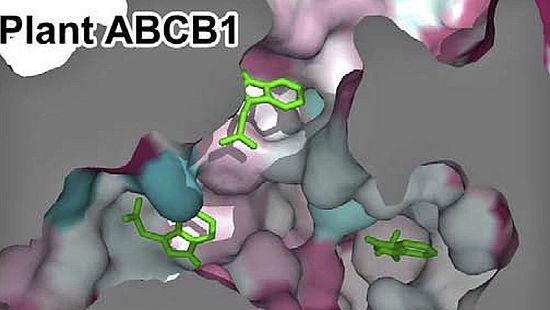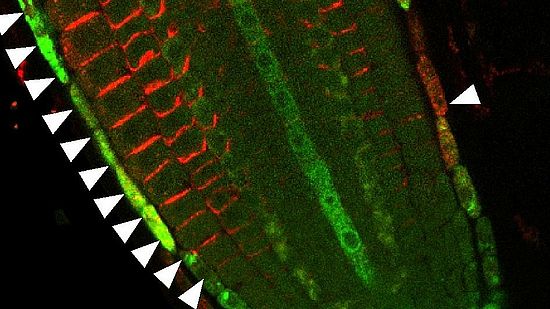Functional interactomics of auxin transport
Molecular Plant Physiology - Hormone Transport
Work in our group is concentrating on the individual roles of auxin catalysts – members of ABCB/PGP- and PIN families - in auxin transport, their functional interaction and regulation and their impact on auxin-mediated plant physiology and plant development. Although ABCB- and PIN-mediated auxin efflux can apparently function independently, ABCBs and PINs are able to interactively and coordinately transport auxin. The current model is that in interacting cells, multilaterally expressed ABCBs minimize apoplastic reflux while polar ABCB-PIN interactions provide the basis for specific, vectorial auxin streams.
Meanwhile, we have substantially characterized the FKBP42, TWISTED DWARF1 (TWD1), as a positive regulator of ABCB-catalyzed auxin transport by protein-protein interaction (Fig. 1). ABCB-TWD1 interaction and thus auxin flows are disrupted by binding of the diagnostic auxin efflux inhibitor, NPA, suggesting that ABCBs and TWD1 are key components of the NPA-sensitive auxin efflux complex. Recent work has identified flavonols as endogenous modulators of auxin transport by inhibiting ABCBs and promoting asymmetric PIN shifts in the root (Fig. 2). Moreover, by means of chemical genomics, we have identified a novel ABCB-specific auxin transport inhibitor, called BUM.
Recent Publications
- Systems approaches reveal that ABCB and PIN proteins mediate co-dependent auxin efflux
Mellor, Nathan L.; Voss, Ute; Ware, Alexander; Janes, George; Barrack, Duncan; et al.
Plant Cell 10.1093/plcell/koac086 APR 8 2022 - Editorial: Translation Regulation and Protein Folding
Castellano, M. Mar; Ferrando, Alejandro; Geisler, Markus; Mock, Hans-Peter; Munoz, Alfonso
Frontiers In Plant Science 10.3389/fpls.2022.858794 MAR 2 2022 - Ins and outs of AlphaFold2 transmembrane protein structure predictions
Hegedus, Tamas; Geisler, Markus; Lukacs, Gergely Laszlo; Farkas, Bianka
Cellular And Molecular Life Sciences 10.1007/s00018-021-04112-1 JAN 2022 - OsRLR4 binds to the OsAUX1 promoter to negatively regulate primary root development in rice
Sun, Chendong; Li, Dongming; Gao, Zhenyu; Gao, Lei; Shang, Lianguang; et al.
Journal Of Integrative Plant Biology 10.1111/jipb.13183 JAN 2022 - A Retro-Perspective on Auxin Transport
Geisler, Markus M.
Frontiers In Plant Science 10.3389/fpls.2021.756968 OCT 5 2021 - ABA homeostasis and long-distance translocation are redundantly regulated by ABCG ABA importers
Zhang, Yuqin; Kilambi, Himabindu Vasuki; Liu, Jie; Bar, Hamutal; Lazary, Shani; et al.
Science Advances 10.1126/sciadv.abf6069 OCT 2021 - A novel miR167a-OsARF6-OsAUX3 module regulates grain length and weight in rice
Qiao, Jiyue; Jiang, Hongzhen; Lin, Yuqing; Shang, Lianguang; Wang, Mei; et al.
Molecular Plant 10.1016/j.molp.2021.06.023 OCT 4 2021 - ABCG transporters export cutin precursors for the formation of the plant cuticle
Elejalde-Palmett, Carolina; San Segundo, Ignacio Martinez; Garroum, Imene; Charrier, Laurence; De Bellis, Damien; et al.
Current Biology 10.1016/j.cub.2021.02.056 MAY 24 2021 - Early stages of legume-rhizobia symbiosis are controlled by ABCG-mediated transport of active cytokinins
Jarzyniak, Karolina; Banasiak, Joanna; Jamruszka, Tomasz; Pawela, Aleksandra; Di Donato, Martin; et al.
Nature Plants 10.1038/s41477-021-00873-6 Early Access: MAR 2021 - Non-steroidal Anti-inflammatory Drugs Target TWISTED DWARF1-Regulated Actin Dynamics and Auxin Transport-Mediated Plant Development
Tan, Shutang; Di Donato, Martin; Glanc, Matous; Zhang, Xixi; Klima, Petr; Bailly, Aurelien; Ferro, Noel; Petrasek, Jan; Geisler, Markus; Friml, Jiri
Cell Reports, 10.1016/j.celrep.2020.108463 DEC 1 2020 - A twist in the ABC: regulation of ABC transporter trafficking and transport by FK506-binding proteins
Geisler, Markus; Hegedus, Tamas
Febs Letters DOI: 10.1002/1873-3468.13983 DEC 2020 - Auxin-transporting ABC transporters are defined by a conserved D/E-P motif regulated by a prolylisomerase
Hao, Pengchao; Xia, Jian; Liu, Jie; Di Donato, Martin; Pakula, Konrad; et al.
Journal Of Biological Chemistry DOI: 10.1074/jbc.RA120.014104 SEP 11 2020 - ABCG36/PEN3/PDR8 Is an Exporter of the Auxin Precursor, Indole-3-Butyric Acid, and Involved in Auxin-Controlled Development
Aryal, B; Huynh, J; Schneuwly, J; Siffert, A; Liu, J; Alejandro, S; Ludwig-Muller, J; Martinoia, E; Geisler, M
FRONTIERS IN PLANT SCIENCE, 10 10.3389/fpls.2019.00899 JUL 9 2019 - HSP90 and co-chaperones: a multitaskers' view on plant hormone biology
di Donato, M; Geisler, M
FEBS LETTERS, 593 (13):1415-1430; SI 10.1002/1873-3468.13499 JUL 2019 - …

PD Dr. Markus Geisler
University of Fribourg
Department of Biology
1700 Fribourg
Tel: +41 (0)26 300 88 27
Research topics
- Interactomics and cell biology of auxin transport complexes
- Drug-modulation of transport complexes
- Regulation of auxin catalystis by protein phosphorylation
- Chemical genetic screens for natural and synthetic growth regulators
- In silico analysis of transport complex functionality and interaction
- Auxin transporter-cytoskeleton interaction
Interdisciplinary
- Hormone transport and action
- Arabidopsis developmental biology
- Transporter structure-function relationships
- Chemical genomics



